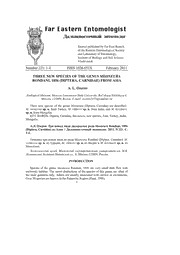
Three new species of the genus Meoneura Rondani, 1856 (Diptera, Carnidae) from Asia. PDF
Preview Three new species of the genus Meoneura Rondani, 1856 (Diptera, Carnidae) from Asia.
Number 221: 1-4 ISSN 1026-051X February 2011 THREE NEW SPECIES OF THE GENUS MEONEURA RONDANI, 1856 (DIPTERA, CARNIDAE) FROM ASIA A. L. Ozerov Zoological Museum, Moscow Lomonosov State University, Bol’shaya Nikitskaya 6, Moscow 125009, Russia. E-mail: [email protected] Three new species of the genus Meoneura (Diptera, Carnidae) are described: M. vernicosa sp. n. from Turkey, M. vikhrevi sp. n. from India, and M. kerzhneri sp. n. from Mongolia. KEY WORDS: Diptera, Carnidae, Meoneura, new species, Asia, Turkey, India, Mongolia. А.Л. Озеров. Три новых вида двукрылых рода Meoneura Rondani, 1856 (Diptera, Carnidae) из Азии // Дальневосточный энтомолог. 2011. N 221. C. 1-4. Описаны три новых вида из рода Meoneura Rondani (Diptera, Carnidae): M. vernicosa sp. n. из Турции, M. vikhrevi sp. n. из Индии и M. kerzhneri sp. n. из Монголии. Зоологический музей, Московский государственный университет им. М.В. Ломоносова, Большая Никитская ул., 6, Москва 125009, Россия. INTRODUCTION Species of the genus Meoneura Rondani, 1856 are very small dark flies with uniformly habitus. The surest distinctions of the species of this genus are often of the male genitalia only. Adults are usually associated with carrion or excrements. Over 50 species are known in the Palaerctic Region (Papp, 1998). 1 The descriptions of three new species from India, Mondolia and Turkey are given below. The holotype of M. kerzhneri sp. n. is deposited in Zoological Institute, St.- Petersburg (ZISP); the holotypes of other two species are kept in the Zoological Museum of Moscow University, Moscow (ZMUM). DESCRIPTIONS OF NEW SPECIES Meoneura vernicosa Ozerov, sp. n. Figs 1, 2 MATERIAL. Holotype – , Turkey: Antalya, ruins of Sillyon, 36.988600ºN, 30.983834ºE, 2.X 2007, coll. by А.L. Ozerov (ZMUM). Paratypes: 2, the same label as in holotype; 5, 2, Turkey: "Turk, Side, sand dunes (~sea)", 25.IX, 1.X 2007, coll. by N.E. Vikhrev (all paratypes in ZMUM). DESCRIPTION. MALE, FEMALE. Body length 1.1-1.7 mm; wing length 1.1- 1.8 mm. Frons, face, genae and antennae dark brown. Frontal triangle black, extended nearly to lunula, shining. Postcranium black. Thorax black, scutum shining, pleural sclerites subshining. Four pairs of dorsocentral setae. Scutellum microtomentose. Legs blackish, only tarsi brown or yellowish. Wing hyaline. Knob of halter yellow, stalk blackish. Abdomen black, shining. Epandrium with one pair of epandrial processes only (sursyli). Surstylus simple, stick-like (Fig. 1, 2). DIAGNOSIS. New species resembles Meoneura hungarica Papp, 1977 and M. caucasica Ozerov, 1991 by the structure of male genitalia, but scutum of both these species is grayish pruinose (Papp, 1977; Ozerov, 1991). Besides, M. hungarica with three pair of dorsocentral setae, and M. caucasica with one pair of dorsocentral setae only (M. vernicosa sp. n. with four pair). Meoneura vikhrevi Ozerov, sp. n. Figs 3, 4 MATERIAL. Holotype – , India: Rajastan, Sawai Madhopur, 26.0ºN, 76.4ºE, 25-27.II 2011, coll. by N.E. Vikhrev (ZMUM). Paratype: , the same label as in holotype (ZMUM). DESCRIPTION. MALE, FEMALE. Body length 1.2-1.3 mm; wing length 0.8- 1.0 mm. Frons black in upper half and dark brown anteriorly. Face, genae, postcranium and antennae black. Frontal triangle extended to lunula, shining. Thorax black, scutum and pleural sclerites subshining. One pair of dorsocentral setae. Scutellum microtomentose. Legs blackish, only tarsomeres 1 and 2 of hind leg yellowish. Wing tinged with whitish. Knob of halter yellow, stalk blackish. Abdomen black, subshining. Epandrium with one pair of epandrial processes only (sursyli). Surstylus simple, hook-like in lateral view (Fig. 3, 4). 2 DIAGNOSIS. New species resembles Meoneura polita Sabrosky, 1959 descri- bed from North America (Sabrosky, 1959), by the habitus and structure of male genitalia. However, the surstyli of a new species are more massive, with acute apex. ETYMOLOGY. The new species is named after Nikita Vikhrev, who collected the specimens of this species. Figs 1–4. Meoneura vernicosa sp. n. (1, 2) and Meoneura vikhrevi sp. n. (3, 4): 1, 3 – epandrium and surstyli, dorsally; 2, 4 – epandrium and surstylus, laterally. Meoneura kerzhneri Ozerov, sp. n. Figs 5, 6 MATERIAL. Holotype – , Mongolia: "Central Aimak, environs of Nalaych, 25. VI 1967", coll. by I.M. Kerzhner (ZISP). DESCRIPTION. MALE. Body length 1.2 mm; wing length 0.9 mm. Frons, face, genae, postcranium and antennae blackish. Frontal triangle black, extended nearly to lunula, shining. Thorax black, scutum, pleural sclerites and scutellum microtomentose. Two pairs of dorsocentral setae. Legs blackish. Wing 3 tinged with whitish. Knob of halter yellow, stalk brownish. Abdomen black, subshi- ning. Epandrium with two pairs of epandrial processes: surstylus and lamella fused (Fig. 5, 6). Surstylus short, stick-like. Lamella longer than surstylus, with long hairs. Figs 5, 6. Meoneura kerzhneri sp. n.: 5 – epandrium and surstyli, dorsally; 6 – epandrium and surstylus, laterally. DIAGNOSIS. New species resembles Meoneura milleri Gregor, 1973, descrybed from Slovakia (Gregor, 1973), by the habitus and structure of genitalia. However, the surstyli of new species are shorter than in M. milleri, and the last species with three pairs of dorsocentral setae. ETYMOLOGY. This species is named in memory of the famous Russian entomologist Izyaslav Moiseevich Kerzhner, who collected it in Mongolia. REFERENCES Gregor, F. 1973. Two new species of the genus Meoneura Rondani (Diptera, Milichiidae) from Czechoslovakia. Acta entomologica bohemoslovaca. 70: 137–141. Ozerov, A.L. 1991. New species of Micropezidae, Piophilidae and Carnidae (Diptera) from the USSR. Vestnik Zoologii. 6: 7–12. Papp, L. 1977. New species and records of Hungarian Odiniidae, Milichiidae and Carnidae (Diptera). Acta Zoologica Academiae Scientiarum Hungaricae 23(1-2): 171–181. Papp, L. 1998. 3. 15. Family Carnidae. In: Papp, L., Darvas L. (eds). Contributions to a Manual of Palaearctic Diptera. Budapest. 3: 211–217. Sabrosky, C.W. 1959. The Nearctic species of the filth fly genus Meoneura (Diptera, Mili- chiidae). Annals of the Entomological Society of America. 52(1): 17–26. 4
